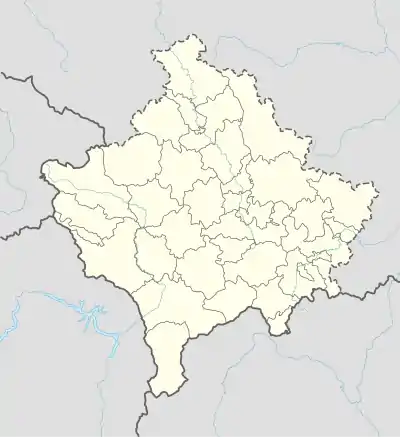Gornje Nerodimlje
Gornje Nerodimlje (Albanian: Nerodimë e Epërme, Serbian Cyrillic: Горње Неродимље) is a village in Ferizaj municipality, in southeastern Kosovo. The village was first mentioned in the Gračanica charters (1311–16) of Serbian King Stefan Milutin.
Gornje Nerodimlje
| |
|---|---|
village | |
.jpg.webp) Monastery of Emperor Uroš (1899) | |
 Gornje Nerodimlje | |
| Coordinates: 42.3703°N 21.0786°E | |
| Location | |
| District | Ferizaj |
| Municipality | Ferizaj |
| Population (2011)[1] | |
| • Total | 1,648 |
Geography
The settlement lies in the cadastral area of Gornje Nerodimlje which has 1107 hectares.
History
The village was first mentioned in the Gračanica charters (1311–16) of Serbian King Stefan Milutin. Serbian King Stefan Dečanski had one of his royal courts here, in which the Dečani chrysobull was written in 1330. Emperor Stefan Dušan and his son Uroš V had their court near the fortresses of Gornji and Donji Petrič,[2] where many charters, letters and other documents were written.
Stefan Milutin died in 1321, in the courtyard of the Church of the Holy Archangels,[3] from where his body was transferred to his endowment, the Banjska monastery. In 1371, the last monarch of the Nemanjić dynasty, Emperor Uroš V, also died, in Nerodimlje. In 1705, his body was transferred to the Jazak monastery in Fruška Gora (in northern Serbia).
According to the Ottoman defter (tax registry), there was 71 Serbian households and two Orthodox priests. Several church buildings and ruins are located in the village.
The local monastery and church was built in the 14th century, and renovated in 1700. Up until 1975, a giant black pine tree grew above the church, said to have been planted by Stefan Dušan in 1336.
The Monastery of St. Uroš[4] is situated in a hamlet above the village, and it is said to have been founded by Empress Jelena on the grave of her only son Uroš V. His remains were transferred to Jazak from this church. There are also ruins of the Church of St. Nicholas and foundations of three churches whose dedication is unknown.
Several ethnic Serbs were abducted from the village during the Kosovo War (1998–99).[5] The Church of the Holy Archangels was looted and burnt.[6] Also, all of the Serbian gravestones were desecrated or destroyed.[7]
| Ethnic group | 1948 | 1953 | 1961 | 1971 | 1981[8] | 1991 | 2011 |
|---|---|---|---|---|---|---|---|
| Albanians | 935 (49.58%) | 1638 (99.39%) | |||||
| Serbs | 686 (36.37%) | 0 (0.00%) | |||||
| Others | 19 | 10 | |||||
| Total[9] | 845 | 935 | 1219 | 1267 | 1641 | 1886 | 1648 |
References
- 2011 Kosovo Census results
- "Велики и Мали Петрич". Споменици културе у Србији. Retrieved 12 September 2014.
- "Црква Св. арханђела". Споменици културе у Србији. Retrieved 12 September 2014.
- "Црква Успења Богородичиног ("Манастир Св. Уроша")". Споменици културе у Србији. Retrieved 12 September 2014.
- Nataša Kandić; Fond za humanitarno pravo (2001). Abductions and disappearances of non-Albanians in Kosovo. Humanitarian Law Center. p. 262. ISBN 9788682599265.
- Balcanica. Srpska Akademija Nauka i Umetnosti, Balkanolos̆ki Institut. 2009. p. 265.
- Review of International Affairs. Federation of Yugoslav Journalists. 2000. p. 75.
- 1981 Census, Kosovo Archived 2012-03-17 at the Wayback Machine
- "Kosovo censuses 1948–1991". Archived from the original on 13 January 2020. Retrieved 12 September 2014.